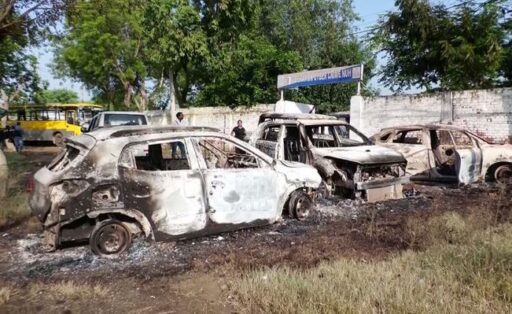
On July 31, 2023, a seemingly routine Braj Mandal Jalabhishek Yatra, organized by the Vishva Hindu Parishad (VHP) and Bajrang Dal, triggered violent clashes in Nuh district of Haryana. The procession, meant to perform symbolic puja at the Nalhar Mahadev temple, quickly transformed into an episode of communal unrest involving stone pelting, burning of vehicles, and damage to public and religious property
Timeline of Events
-
Participants began the yatra from Gurugram, but tensions rose before arrival in Nuh.
-
Nearly 2,500 people reached the outskirts near Khedla Mod when unrest erupted. Protesters pelted stones; cars and police vehicles were set ablaze. Assam-style chaos spread to Sohna and Gurugram within hours
- Local police quickly imposed Section 144, suspended mobile internet services, and deployed paramilitary forces across affected areas
Casualties and Arrests
The clashes claimed at least seven lives, injured over 200 people, and left multiple communities traumatized. Authorities arrested 116–166 individuals and registered dozens of FIRs across the region
auses: Provocation, Intelligence Gaps, and Planning
-
A provocative social media post from a cow vigilante accused of previous violence, Monu Manesar, inflamed tensions. He was rumored to participate, heightening fear and mistrust
- Witnesses allege the violence was organized days earlier—teams stockpiling bottles, stones, and modifying vehicles to avoid identification
- Local and district officials reportedly failed to act despite advance warnings. Only 700 home guards were deployed, not enough to quell the unrest successfully
Aftermath: Bulldozers, Demolitions, and Accusations
In the days following the unrest, authorities conducted demolition drives on shops and homes in Nuh district—many belonging to Muslim residents. Those affected claimed they received no prior notice or fair hearing. Critics labelled it vindictive governance, echoing a trend where bulldozers serve as tools of punitive justice
Official Response and Criticism
-
Haryana Chief Minister Manohar Lal Khattar described the events as “pre‑planned mischief” and announced legal penalties for rioters, referencing a 2021 state law enabling fines for damage to public and private property
- Opposition parties accused the state government of administrative failure. Former CM Bhupinder Singh Hooda blamed intelligence oversight, stating that early response could have prevented escalation
Human Cost: Arrests and Fear Among Communities
Most arrests involved Muslim residents. Human rights lawyers flagged arbitrary detentions and pointed out that several detained individuals were not involved in the violence. A high court temporarily stayed demolition orders while seeking clarification from the state
Rescue stories emerged of Sikh individuals helping Muslim families to safety—an act of solidarity amid communal crisis
Impact on Political and Communal Landscape
The Nuh violence became emblematic of growing communal frictions. State and regional politics capitalized on the turmoil:
-
BJP used the incident to justify stronger law-and-order measures and demolition actions.
-
Opposition leaders used it to argue about erosion of civil liberties and misuse of municipal powers.
The episode foreshadowed electoral politics, influencing narratives during the state and national polls.
A Checklist of Failures and Lessons
-
Underprepared administration: Intelligence ignored, inadequate force deployment.
-
Social media provocation: Unchecked online rumors intensified mistrust.
-
Legal overreach: Demolitions and arrests without due process.
-
Polarized politics: Actions interpreted through ideological lenses.
Broader Trends: Bulldozers as Politics
Haryana’s actions reflect a broader pattern in BJP-ruled states—demolition as symbolic reprimand. Critics argue it disproportionately targets vulnerable minority communities without legal recourse, reinforcing power asymmetries
Final Reflection
The Nuh riots of 2023 remain a painful reminder of what can happen when communal symbolism, poor governance, and ideological polarization collide. The violence shook Mewat’s fragile fabric, incited fear in neighborhoods, and sparked debates on political exploitation, rule of law, and the future of secular democracy in India.